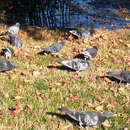en
names in breadcrumbs


Feral pigeons have been used extensively in laboratories because they are domesticated and found in abundance throughout the world. These studies include flight mechanisms, thermoregulation, water metabolism, genetics of color patterns, and Darwinian evolutionary biology.
Perception Channels: visual ; tactile ; acoustic ; chemical
Since pigeons are often fed by well-meaning city dwellers, their numbers are high. Wild rock doves also have no special status.
US Migratory Bird Act: no special status
US Federal List: no special status
CITES: no special status
State of Michigan List: no special status
IUCN Red List of Threatened Species: least concern
A large number of pigeons living in a small area can be a nuisance to farmers. Some diseases (e.g., histoplasmosis) may be spread in pigeon droppings.
Eaten by humans and used for laboratory research.
Rock doves feed in the early morning and in the mid-afternoon on the open ground. They eat mainly seeds. Studies of pigeons in a semi-rural part of Kansas found that their diet includes the following: 92% corn, 3.2% oats, 3.7% cherry, along with small amounts of knotweed, elm, poison ivy, and barley. In cities, feral pigeons also eat popcorn, cake, peanuts, bread, and currants. Female rock doves need to eat a diet somewhat higher in protein and calcium in order to have the nutritional resources to lay eggs.
Wild Columba livia are native to Europe, North Africa, and southwestern Asia. Feral pigeons are found worldwide, including throughout all of North America. It should be noted that occurrence within this range is not evenly distributed (see habitat).
Biogeographic Regions: nearctic (Introduced ); palearctic (Native ); oriental (Introduced ); ethiopian (Introduced , Native ); neotropical (Introduced ); australian (Introduced ); oceanic islands (Introduced )
Other Geographic Terms: cosmopolitan
Wild rock doves nest in crevices along rocky seaside cliffs, close to agriculture or open shrub vegetation. Feral pigeons live in old farm buildings in rural areas. In cities, the skyscrapers tend to take the place of their natural cliff surroundings.
Terrestrial Biomes: desert or dune ; savanna or grassland ; chaparral ; forest ; rainforest ; scrub forest
Average lifespan
Status: captivity: 35.0 years.
Average lifespan
Status: wild: 6.0 years.
The rock dove has a dark bluish-gray head, neck, and chest with glossy yellowish, greenish, and reddish-purple iridescence along its neck and wing feathers. Females tend to show less iridescence than the males. The bill is dark grayish-pink. Two dark bands across the wings are seen in most pigeons, and one bluish-gray band across the tail. Rock doves and feral pigeons can be divided into a large number of different phenotypes, or groups based on outward characteristics. Some of these classifications are the blue-bar, blue checker, dark checker, spread, and red phenotypes.
Other Physical Features: endothermic ; bilateral symmetry
Average mass: 358.7 g.
Some common predators of feral pigeons in the North America are opossums (Didelphis virginiana), raccoons (Procyon lotor), great horned owls (Bubo virginianus), and eastern screech-owls (Otus asio). Other predators include the golden eagle (Aquila chrysaetos), American kestrels (Falco sparverius), and peregrine falcons (Falco peregrinus).
Known Predators:
Pairs may be formed at any point during the year. These pairs are formed for life. Each bird works cooperatively on most aspects of reproduction and young-rearing. The male builds the nest, and the eggs are laid shortly after the nest is finished. Both males and females incubate the eggs. Eggs hatch approximately 19 days after being laid.
Average time to hatching: 19 days.
Key Reproductive Features: iteroparous ; gonochoric/gonochoristic/dioecious (sexes separate); sexual ; oviparous
Average time to hatching: 18 days.
Average eggs per season: 2.
Average age at sexual or reproductive maturity (male)
Sex: male: 140 days.
Average age at sexual or reproductive maturity (female)
Sex: female: 140 days.